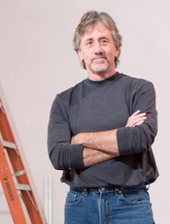Stephen Nowlin is Vice President, Director, Alyce de Roulet Williamson Gallery at Art Center College of Design, in Pasadena, California, where his curatorial practice has included many exhibitions on the intersection of art and science.
I love science. I could never be a scientist.
At birth, I imagine the DNA passed my way just wasn’t sequenced for an easy chumminess with math and formulas. Nor did I have welded into my early existence a storehouse of patience - no, not nearly enough to spend years later in a remote corner of the knowledge spectrum, chipping away clue-by-clue at some stubborn secret. I love science, but on the other hand my schooled exposure to it, like that of so many others, is recalled as having been pretty dull - gnarled textbook chapters with threatening questions at their conclusion, and a system of rewards and failures focused almost entirely on memorizing lots of stuff. Nowhere in the mind-numbing thicket of pages and texts and diagrams and quizzes was it ever expressed to me that science has a soul. No poetry ever interrupted the unyielding stream of facts and figures demanding to be recalled. The rare field-trips to science museums were a day’s escape from the classroom, a ride on the bus, a lark punctuated by artifacts behind glass, lectures and captions, labels, and more boring linearity. It was almost as bad as church.
What an unlikely overture then, one might rightfully observe, to what eventually became my affection for the discipline of science and its deployment of rigor, reason, and painstaking evidence-gathering to further the cause of humanity. I wasn’t supposed to like science, even, so what interrupted the inevitable product of this forgone conclusion?
Science isn’t just about what science knows - it’s also about what science, as a human concept, means in the culture where humans reside. Meaning is invested in symbols, and symbols are elusive things, irrational and everywhere, and mostly harvested in the province of art. Symbols seem like the opposite of plain facts — they contain hyperactive memes, and spread like viruses, infiltrating and irritating cultural stasis, sometimes to the breaking point. Symbols help make change. Dignified facts and rascally symbols are closely aligned, though, and both are forged in the furnaces of science. I think I was led to science by its symbols, by its art. I admire science for its brains, but what it symbolizes is what seduced me. And what it symbolizes is that we humans are audacious and unafraid, we are the gods of a rational quest for truth. As it may demand we shed sometimes treasured shackles from the past, science is the essence of chutzpah - with an exquisitely dissonant beauty found in its minutia and its unfathomable scale. Science is liberating, a constant provocateur. But perhaps in the end what science best symbolizes can be reduced to a tiny and splendid fact about ourselves - we humans are simply and helplessly curious, and nothing for long impedes the force of our curiosity. Science is important for many reasons, but it’s important to me because of its spirit.
 Published by
Published by